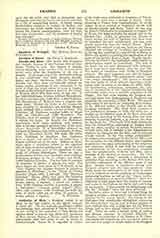

Amalarius of Metz, a liturgical writer, b. at Metz, in the last quarter of the eighth century; d. about 850. He was formerly considered a different personage from Amalarius of Troves (Trier), but of late, owing to the researches of Dom Morin, the opinion seems to prevail that about 811, Amalarius of Metz became Bishop of Troves, which diocese he relinquished after two years to act as envoy to Constantinople. Hence he is regarded as author of the works once attributed to Amalarius of Troves. He was for some time a disciple of Alcuin. After returning to France from Constantinople, he would appear to have assisted at important synods held at Aix-la-Chapelle and Paris. Later, he was sent by Louis le Dobonnaire as ambassador to Gregory IV at Rome, this being probably his second visit to the Eternal City. Later, he governed the Diocese of Lyons during the exile of Agobard, and there tried to introduce his new antiphonary, but met with strong opposition from the deacon Florus. When Agobard was restored to his see, both he and Florus attacked the writings of Amalarius and succeeded in having him censured at a synod held at Kiersy in 838 for his opinion concerning the signification of the parts of the divided Host at Mass. Finally Amalarius was involved in the theological controversies on predestination raised by Gottschalk. The date of his death has not been determined with certainty, but it must have been shortly after the year 850. The works of Amalarius treat chiefly of liturgical subjects. His most important and also his longest treatises are entitled “De ecclesiasticis officiis” and “De ordine antiphonarii”. The former is divided into four books, in which without observing a strict, logical order he treats of the Mass, the Office, different benedictions, ordinations, vestments, etc., giving an explanation of the various formularies and ceremonies rather than a scientific exposition of the liturgy. The first book explains the liturgical seasons and feasts from Septuagesima to Pentecost and especially the ceremonies of Holy Week. The second book treats of the times for conferring Holy Orders, of the different orders in the Church and of the liturgical vestments. The third book contains a few preliminary chapters on bells, the choir, etc., a treatise on the different parts of the Mass celebrated pontifically according to the Roman Rite, and Some chapters on special subjects, e.g. Advent, the Mass for the Dead, etc. The fourth book deals principally with the Divine Office, explaining its integral parts and the offices peculiar to certain liturgical seasons or feast days, but it contains a few supplementary chapters on obsequies for the dead and on subjects already treated. In the “De ordine antiphonarii” he explains the arrangement of the Divine Office and the variations for the different feasts, and considers in particular the origin and meaning of the antiphons and responses; indeed in this work he would seem a commentator on his own antiphonary compiled from the antiphonaries of Rome and Metz, and a defender of his method of composition. His “Eclogae de officio miss” contains a description of pontifical Mass according to the Roman Rite and a mystical explanation of the different parts of the Mass. Several letters of Amalarius dealing with liturgical subjects have also been preserved. Dom Morin denies the authenticity of the letter of Amalarius in response to certain questions of Charlemagne concerning baptism, as well as the “Forma institutionis canonicorum et sanctimonialium”, which is a collection of rules taken from the decrees of councils and works of the Fathers, for clerics and nuns living in community. Unfortunately his antiphonary and also his “Embolis” have not been preserved.
Amalarius seems to have had a strong liking for liturgical studies, a liking which was stimulated and fostered by his master Alcuin. His travels to the East gave him considerable information concerning the Oriental rites, but his stay in Rome appears to have imbued him with a deep love for the Roman liturgy and to have greatly influenced his liturgical work. There he made a special study of rubrics and Roman customs; he inquired diligently of Theodore, the archpriest of the basilica of St. Peter, concerning the formularies and ceremonies there in use, and even sought to obtain copies of the liturgical books to bring to France. Living just at this time when the liturgy was changing, when the fusion of the Roman and Gallican uses was taking place, he exercised a remarkable influence in introducing the present composite liturgy, which has finally supplanted the ancient Roman Rite. He sought to carry out the desire of the Emperor to introduce the Roman liturgy in order to obtain uniformity, but at the same time, like Alcuin and other liturgists of his age, he combined with the Roman whatever he deemed worth preserving in the Gallican Rite, as may be easily seen in his commentary on his own antiphonary. The chief merit of his works consists in the fact that they have preserved much accurate and valuable information on the state of the liturgy at the beginning of the ninth century, so that a comparison may easily be made between it and the present liturgy to determine what changes have occurred and to trace the development that has taken place. The most serious defect in his writings is an excessive mysticism which led him to seek farfetched and even absurd symbolical origins and meanings for liturgical formulas and ceremonies, but the fault may be in a measure excused since it was common to all liturgical writers of that time. He may also have used more liberty in composing, changing, and transposing liturgical texts than ecclesiastical authority in later ages would permit, when the necessity of unity in the liturgy was more imperatively felt. In spite of these faults he exercised great influence on the development of the present Roman liturgy and his works are very useful for the study of the history of the Latin liturgies.
J. F. GOGGIN

